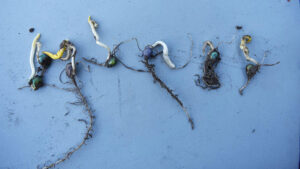Section Title
Impact of Cold Soil on Germinating Corn
- Corn
Cold soil temperatures following planting are not favourable for corn germination or seedling development. Research has shown that temperatures at or below 10 C are most damaging to the germination and emergence process, especially if the cold temperatures persist long after planting.
In corn, kernels must absorb about 30 per cent of their weight in water before germination begins (by comparison, soybeans must absorb about 50 per cent of their weight in water). Cool conditions are decidedly unfavourable when a rainfall occurs and the seed absorbs, or imbibes, the cold water for germination to occur.
Imbibitional chilling injury may result when water colder than 10 C is imbibed, and effects can be particularly severe in situations where seed was planted into cool soils (10 C or colder), combined with cold rain or melting snow after planting. The most critical time for imbibition is within 24 hours of planting. The absorption of cold water can disrupt the reorganization of cells during rehydration and can result in a loss of seed vigour, or seed death. Note: A cold, heavy rain after planting seems to increase the chances of imbibitional injury, probably because it overwhelms the ability of the soil to warm the water before it reaches the seed (Source: Joel Ransom, NDSU).
There are two distinct symptoms of imbibitional chilling injury:
- Stunting or death of seminal root system
- Deformed elongation of the mesocotyl (“corkscrew” of the shoot tissues)
- Delayed or complete failure to emerge from the ground

Imbibitional chilling injury is more closely related to physical damage to the outer cell tissues that literally cause death of the plant part or inhibit further elongation of the affected area. Thus, chilling injury to only part of the circumference of the mesocotyl results in the “corkscrew” symptom, as the undamaged sections of the mesocotyl continue to elongate.
Non-imbibitional chilling injury is another common phenomenon that occurs during the emergence process, following successful germination. Symptoms of non-imbibitional chilling injury include:
- Kernels that have swollen but failed to exhibit further signs of germination
- Kernels with arrested development of the radicle root and/or coleoptile following the initiation of germination
The result of cold injury? If germination is impacted, poor stands could result, impacting yield potential. Plants that develop from injured seedlings may also be stunted and develop more slowly than normal plants. This can result in unevenness in the growth stages of plants within the field and delayed plants may act as a weed to a more advanced crop.











